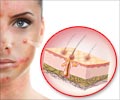Vitiligo is a pigmentation disorder resulting in de-pigmentation of skin. Melanocytes are responsible for normal skin color. In vitiligo melanocytes either die or are unable to function properly.
The exact cause of vitiligo is unknown. However genetic, autoimmune, neural, and viral causes are thought to induce vitiligo. Oxidative stress may be another cause.It may affect the skin, hair and sometimes the mucus membrane. It affects about 8 percent people across the world and 1 percent in United States.
Vitiligo manifests itself as patches of hypopigmentation in hyperpigmented areas like face, elbows, hands, etc.
In vitiligo the epidermis contain high levels of hydrogen peroxide. This leads to oxidative stress in the epidermis and damages the melanocytes.
Besides being a cosmetic problem, vitiligo is also associated with the development of Addison’s disease, pernicious anemia and insulin dependent diabetes mellitus.
Vitiligo affects the quality of a person’s life. It has an adverse impact on the self esteem, intimate relationships, body image and results in undue emotional stress.
Since the exact cause of vitiligo is unknown, a multifaceted approach is required.
Camouflaging Depigmented Skin:
In cases of mild vitiligo, makeup is used to conceal or camouflage the patches. If the vitiligo patient is pale-skinned, the patches can be made light by avoiding sunlight-exposure and tanning of the unaffected regions of the skin.
Waterproof sunscreen that provides protection against both ultraviolet A (UVA) and ultraviolet B (UVB) and has at least sun protection factor (SPF) of 15 should be reapplied every 90 minutes. It should be replied after sweating and swimming.
Restoring Pigmentation:
Restoration of the pigment is the oldest form of vitiligo treatment. Photochemotherapy and Phototherapy are techniques used for restoring pigmentation. Photochemotherapy is the blend of UVA (Psoralen plus UVA [PUVA]) and photoactive chemicals (such as khellin, Psoralen, etc.) Phototherapy on the other hand includes UVA and narrow band of UVB. Adverse effects of phototherapy are skin malignancies, blistering and hyperpigmentation of unaffected skin.
Topical Medications:
Corticosteroids are widely used as topical treatment of vitiligo. Betamethasone valerate is the initially recommended corticosteroid for use on skin. Clobetasol propionate, a high potency steroid, should be used if results are not achieved by betamethasone use.
High potency corticosteroids can be applied as a thin layer is the affected skin. This reduces the risk of skin atrophy, striae, hypertrichosis, acne and steroid folliculitis.
Some potential side effects are weight gain, insomnia, agitation and adrenal insufficiency.
Other useful topical choices are calcineurin inhibitors, tacrolimus and pimecrolimus. It is seen that skin lesions on the head and neck respond positively calcineurin inhibitors. Calcineurin inhibitors yield identical results but without the side-effects.
Calcipotriene – a vitamin D analogue is the third effective topical immune-modulatory agent. It accelerates the melanocyte development. Calcipotriene is less effective when used alone but in adjunct therapy it is very effective. Some common adverse effects of calcipotriene are dryness, stinging, burning and erythema.
Complementary Therapy:
Alternative medications offer good results in vitiligo patients. Ginkgo biloba is a traditional Chinese herb. It is very useful owing to its immunomodulatory and anti-oxidant properties. Further researches are needed to establish its efficacy in curing vitiligo.
Surgery:
If medical treatment proves ineffective, surgical implantation of melanocytes in de-pigmented skin can be done. Grafting melanocyte-rich tissue and grafting melanocyte cell suspensions are the two common types of surgeries for vitiligo.
The associated risks are graft failure, scarring and new lesions at the surgery site.
Destroying the Remaining Pigmentation:
If more than 50 percent of the body is affected by vitiligo then de-pigmentation is the best treatment option. Hydroquinone and monobenzone are the de-pigmentation agents that result in the death of the remaining monocytes. Expected results are attained in one month but as long as ten months may be needed. Re-pigmentation, burning and erythema are the possible side-effects.
Extreme sensitivity to sunlight is noticed after complete depigmentation. Sunscreen therefore is very important for patients seeking this treatment.
Although vitiligo is not a very common skin disorder, it definitely poses significant social, psychological and cosmetic challenges.
It can be concluded that proper treatment for vitiligo patients is recommended. Household remedies and treatment from quacks should not be taken, authentic and reliable treatment should be taken.
Reference:
Treatment Options for Vitiligo; Johannes Bennett et al; US Pharmacist 2012
Source-Medindia











